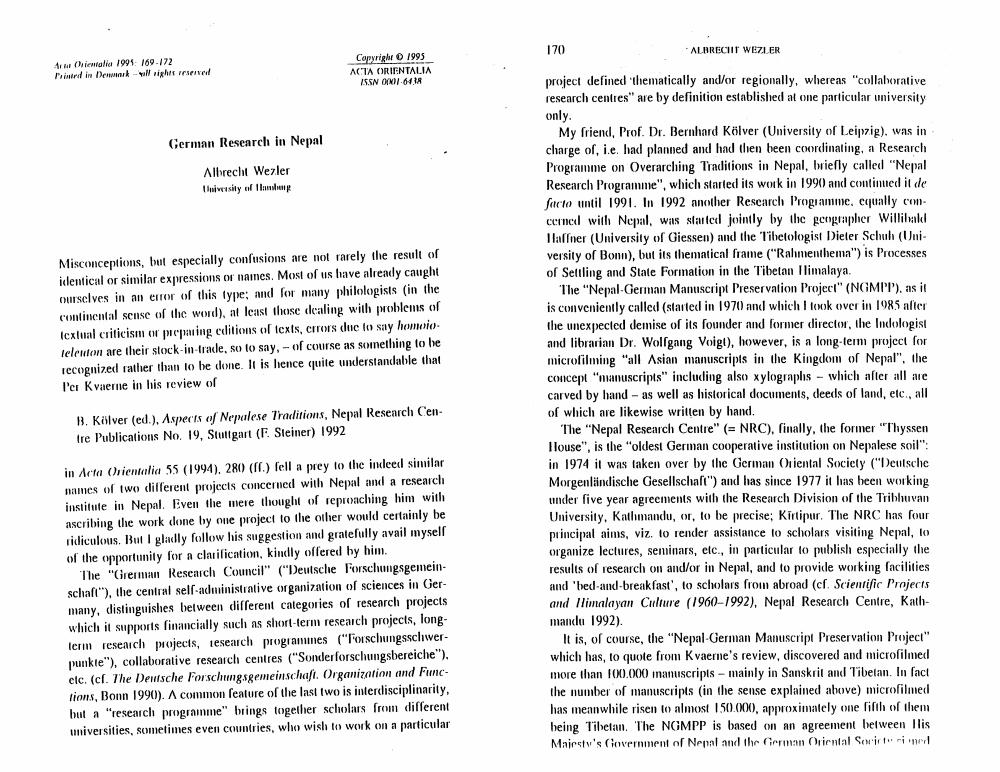Book Title: German Research In Nepal Author(s): A Wezler Publisher: A Wezler View full book textPage 1
________________ 170 - ALBRECHT WEZLER A Chicnalia 1991 169.172 inted in Denmark will right reserved Copyright © 1995 ACTA ORIENTALIA ISSN OM 64 IR German Research in Nepal Albrecht Werler Hissity of Misconceptions, but especially confusions are not rarely the result of identical or similar expressions or names. Most of us have already caught ourselves in an error of this type and for many philologists in the continental sense of the word), at least those dealing with problems of Icxtual criticism or preparing editions of texts, crrors due to say home telenton are their stock-in-trade, so to say. - of course as something to he recognized rather than to be done. It is lence quite understandable that l'er Kvaerne in his review of B. Kilver (ed.). Aspects of Nepalese Traditions, Nepal Research Centre Publications No. 19, Stuttgart (F Steiner) 1992 project defined thematically and/or regionally, whereas "collaborative research centies" are by definition established at one particular university only. My friend, Prof. Dr. Bernhard Kölver (University of Leipzig), was in charge of, i.e. had planned and had then been coordinating, a Research Programme on Overarching Traditions in Nepal, briefly called "Nepal Research Programme", which started its work in 1990 and continued it de facto until 1991. In 1992 another Research Programme, equally con cerned with Nepal, was started jointly by the gengrapher Willibald Haffner (University of Giessen) and the Tibetologist Dieter Schuh (University of Bonn), but its thematical frame ("Ralmenthema") is Processes of Seliling and State Formation in the Tibetan llimalaya. The "Nepal-German Manuscript Preservation Project" (NGMPI), as it is conveniently called started in 1970 and which I took over in 1985 alter the unexpected demise of its founder and former director, the Indologist and librarian Dr. Wolfgang Voigt), however, is a long-term project for microfilming Wall Asian manuscripts in the Kingdom of Nepal", the concept "manuscripts" including also xylographs - which after all are carved by hand - as well as historical documents, deeds of land, etc., all of which are likewise written by hand. The "Nepal Research Centre" (= NRC), finally, the former "Thyssen Ilouse", is the "oldest German cooperative institution on Nepalese soil": in 1974 it was taken over by the German Oriental Society ("Deutsche Morgenländische Gesellschaft") and has since 1977 it has been working under five year agreements with the Research Division of the Tribhuvan University, Kathmandu, or, to be precise; Kirtipur. The NRC has four principal aims, viz. to render assistance to scholars visiting Nepal, lo organize lectures, seminars, elc., in particular to publish especially the results of research on and/or in Nepal, and to provide working facilities and 'bed-and-breakfast', to scholars from abroad (cf. Scientific Projects and llimalayan Culoure (1960-1992). Nepal Research Centre, Kathmandu 1992). It is, of course, the "Nepal-German Manuscript Preservation Project" which has, lo quote from Kvaerne's review, discovered and microfilmed more than 100.000 inanuscripts - mainly in Sanskrit and Tibetan. In fact the number of manuscripts in the sense explained above) microfilmed has meanwhile risen to almost 150.000, approximately one fifth of them being Tibetan. The NGMPP is based on an agreement between llis Mairsty's Government of Nepal and the German Oriental Societ y in Acta Orientalia 55 (1994), 280 (Fr.) fell a prey to the indeed similar names of two different projects concerned with Nepal and a research institute in Nepal. Even the mere thought of reproaching him with ascribing the work done by one project to the other would certainly be ridiculous. But I gladly follow his suggestion and gratefully avail myself of the opportunity for a clarification, kindly offered by him. The "Grerman Research Council" ("Deutsche Forschungsgemeinschaft"), the central self-administrative organization of sciences in Ger many, distinguishes between different categories of research projects which it supports financially such as short-term research projects, longterm research projects, research programmes ("Forschungsschwer punkte"), collaborative research centres ("Sonderforschungsbereiche"), etc. (cf. The Deutsche Forschungsgemeinschali. Organization and Func tions, Bonn 1990). A common feature of the last two is interdisciplinarity, but a "research programme" brings together scholars from different universities, sometimes even countries, who wish to work on a particularPage Navigation
1 2
